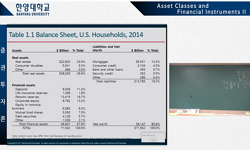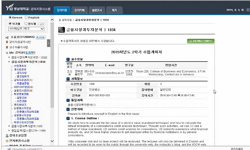In order to confirm whether the monetary policy affect corporate investment or not, this paper examines the validity of the asset price channel and the balance sheet channel among monetary policy transmission mechanisms. Unbalanced dynamic panel model...
http://chineseinput.net/에서 pinyin(병음)방식으로 중국어를 변환할 수 있습니다.
변환된 중국어를 복사하여 사용하시면 됩니다.
- 中文 을 입력하시려면 zhongwen을 입력하시고 space를누르시면됩니다.
- 北京 을 입력하시려면 beijing을 입력하시고 space를 누르시면 됩니다.

통화정책과 기업 설비투자: 자산가격경로와 대차대조표경로 분석 = Monetary Policy and Corporate Investment: Analysis of the Asset Price Channel and the Balance Sheet Channel
한글로보기https://www.riss.kr/link?id=A105961495
- 저자
- 발행기관
- 학술지명
- 권호사항
-
발행연도
2018
-
작성언어
Korean
-
주제어
통화정책 ; 투자 ; 토빈의 q ; 통화정책 파급경로 ; 자산가격경로 ; 대차대조표경로 ; monetary policy ; investment ; Tobin’s q ; transmission mechanism ; asset price channel ; balance sheet channel
-
등재정보
KCI등재
-
자료형태
학술저널
-
수록면
1-36(36쪽)
-
KCI 피인용횟수
0
- 제공처
- 소장기관
-
0
상세조회 -
0
다운로드
부가정보
다국어 초록 (Multilingual Abstract)
In order to confirm whether the monetary policy affect corporate investment or not, this paper examines the validity of the asset price channel and the balance sheet channel among monetary policy transmission mechanisms. Unbalanced dynamic panel model based on system GMM method is employed and annual financial statements data of Korean firms from 2000 to 2016 are used. For estimating the asset price channel, Tobin’s q is used as the independent variable, and for estimating the balance sheet channel, the cross products of liquidity asset ratio and call rate difference or liquidity asset ratio and rate of increase in monetary base are used as interaction independent variables. In addition, debt ratio and operating profit ratio are included as the regressors. The dependent variable is investment ratio (the ratio of real investment amount to real tangible fixed asset amount).
The empirical test results show that there is a statistically significant relation between investment at t and Tobin’s Q at t-1. Considering lowering policy rate possibly increase stock price, and then stock price has a positive relation with Tobin’s Q, the plus signal of Tobin’s Q means that the asset price channel of monetary policy functions statistically significant.
The coefficient of liquidity asset ratio at the former period (t-1) is also estimated as plus – it means that there might be information asymmetry between firms and banks.
Meanwhile, the coefficient of interaction term which is the cross product of liquidity asset ratio and call rate difference is estimated plus and the one which is the cross products of liquidity asset ratio and rate of increase in monetary base is estimated minus. This means that the impact of liquidity asset on investment gets weaker during the time of easing monetary policy; therefore, the balance sheet channel of monetary policy function is statistically significant.
Model estimation by firm size distribution shows that the impacts of the asset price channel and the balance sheet channel are stronger in the smaller firms. Besides, the impact of operating profit on investment is estimated more powerful in the smaller firms rather than in the larger firms. On the contrary, only the debt ratio coefficient of top 50% sized-firm group shows statistically significant minus sign.
This study has policy implications in the aspects of firms’ investment during the time of tightening monetary policy, and external fund premium for smaller firms.
국문 초록 (Abstract)
저자 : 박상준(와세다대학교), 육승환(금융통화연구실) <요약> 본 연구는 통화정책이 기업의 설비투자에 미치는 파급경로를 불균형 동태적 패널모형으로 분석하였다. 2000~...
저자 : 박상준(와세다대학교), 육승환(금융통화연구실)
<요약>
본 연구는 통화정책이 기업의 설비투자에 미치는 파급경로를 불균형 동태적 패널모형으로 분석하였다. 2000~2016년 중 우리나라 기업의 재무제표 데이터(연간)를 이용하여 자산가격경로와 대차대조표경로의 유효성을 검증하였는데 이 과정에서 내생성 문제를 해결하기 위해 시스템 GMM 기법을 적용하였다. 분석 결과, t-1기의 토빈 q는 t기의 투자율과 유의적인 양의 관계를 갖는 것으로 나타났다. 정책금리의 인하가 주가 상승에 긍정적인 영향을 주고 주가 상승이 토빈 q와 양의 상관관계가 있는 점을 고려하면 유의적인 양의 값으로 추정된 토빈q의 계수는 자산가격 파급경로가 작동하고 있음을 의미한다. 전기 유동성자산의 계수도 양의 값을 갖는 것으로 추정되었다. 이는 은행과 기업 간에 정보의 비대칭성이 존재할 가능성을 시사한다. 한편, 유동성자산 비율과 콜금리 차분의 교차항은 양의 값을, 유동성자산과 본원통화 증가율의 교차항은 음의 값을 갖는 것으로 추정되었다. 이는 확장적 통화정책이 실시되고 있을 때에는 투자에 대한 유동성자산의 영향력이 감소하는 것을 의미하는 것으로, 대차대조표경로가 작동하고 있음을 뜻한다. 기업을 규모별로 분류하여 추정한 결과, 기업 규모가 작을수록 자산가격경로와 대차대조표경로가 더 뚜렷하게 작동하는 것으로 보인다. 한편 영업이익률의 투자에 미치는 영향력도 규모가 큰 기업보다는 규모가 작은 기업에서 더 큰 것으로 나타났다. 반면에 부채비율은 상위 50% 기업에서만 유의적인 음의 값을 갖는 것으로 추정되었다. 본 연구는 기업 단위의 분석을 통해 통화정책의 자산가격경로와 대차대조표경로가 작동하여, 통화정책이 기업의 투자결정에 영향을 미친다는 것을 실증적으로 확인한 데 의미가 있다. 또한 통화정책 기조 변화가 기업의 투자결정에 미치는 영향이 기업 규모별로 상이할 수 있음을 보인 것도 정책적 측면에서 시사하는 바가 있다.
참고문헌 (Reference)
1 강민우, "한국경제의 과잉유동성 논란과 금융위기 이후 정책대응 평가" 사회과학연구원 35 (35): 147-163, 2009
2 신현열, "통화정책이 신용경로를 통해 설비투자에 미치는 영향" 한국은행 23-49, 2010
3 한국은행, "통화정책방향"
4 한국은행, "통화정책방향"
5 육승환, "통화정책 완화기조 장기화가 금융기관 위험선호에 미치는 효과"
6 홍기석, "최근 기업 설비투자 결정요인의 미시적 분석" 한국은행 12 (12): 1-52, 2006
7 김현의, "저인플레이션하에서 통화정책과 기업투자" 한국은행 13 (13): 1-55, 2007
8 유재원, "일본의 장기침체와 정책대응: 평가와 교훈" 한국동북아경제학회 25 (25): 121-164, 2013
9 박상준, "일본경제의 장기침체와 한국경제에의 시사점" 서울대학교 시장과정 부연구센터 2013
10 남창우, "세제변화가 기업의 투자 및 배당결정에 미치는 영향" 한국개발연구원 2015
1 강민우, "한국경제의 과잉유동성 논란과 금융위기 이후 정책대응 평가" 사회과학연구원 35 (35): 147-163, 2009
2 신현열, "통화정책이 신용경로를 통해 설비투자에 미치는 영향" 한국은행 23-49, 2010
3 한국은행, "통화정책방향"
4 한국은행, "통화정책방향"
5 육승환, "통화정책 완화기조 장기화가 금융기관 위험선호에 미치는 효과"
6 홍기석, "최근 기업 설비투자 결정요인의 미시적 분석" 한국은행 12 (12): 1-52, 2006
7 김현의, "저인플레이션하에서 통화정책과 기업투자" 한국은행 13 (13): 1-55, 2007
8 유재원, "일본의 장기침체와 정책대응: 평가와 교훈" 한국동북아경제학회 25 (25): 121-164, 2013
9 박상준, "일본경제의 장기침체와 한국경제에의 시사점" 서울대학교 시장과정 부연구센터 2013
10 남창우, "세제변화가 기업의 투자 및 배당결정에 미치는 영향" 한국개발연구원 2015
11 박상준, "불황터널: 진입하는 한국, 탈출하는 일본" 매일경제출판사 2016
12 유재원, "미국 양적완화 정책의 국제적 파급효과 분석-한⋅중⋅일 3개국을 중심으로" 한국동북아경제학회 27 (27): 41-70, 2015
13 채희율, "내생적 통화공급과 통화정책의 효과" 한국금융학회 31 (31): 75-108, 2017
14 빈기범, "기업의 예비적 현금보유가 경기침체에 미치는 영향" 한국재무관리학회 31 (31): 173-214, 2014
15 윤재호, "금융환경 변화가 통화정책 파급경로에 미치는 영향에 관한 문헌 연구- 비전통적 파급경로를 중심으로 -" 이화사회과학원 28 : 103-144, 2012
16 野口悠紀雄, "戦後日本経済史" 新潮社 2008
17 野口旭, "失われた10年の真 因は何か" 東洋経済新報社 79-110, 2003
18 Bank of Japan, "“Basic Figures of the Flow of Funds: Fourth Quarter of 2016" Research and Statistics Department, Bank of Japan 2017
19 Hori, K., "What Caused Fixed Investment to Stagnate During the 1990s in Japan? Evidence from Panel Data of Listed Companies" 57 (57): 283-306, 2006
20 Inoue, T., "Were There Structural Breaks in the Effects of Japanese Monetary Policy? Re-evaluating Policy Effects of the Lost Decade" 22 : 320-342, 2008
21 Lindenberg, E., "Tobin's q Ratio and Industrial Organization" 54 (54): 1-32, 1981
22 Hosono, K., "The Transmission Mechanism of Monetary Policy in Japan: Evidence from Banks' Balance Sheets" 20 : 380-405, 2006
23 Hayashi, F., "The Relation Between Firm Growth and Q with Multiple Capital Goods : Theory and Evidence from Panel Data on Japanese Firms" 59 (59): 731-753, 1991
24 Pennings, S., "The Impact of Monetary Policy on Financial Markets in Small Open Economies : More or Less Effective During the Global Financial Crisis?" 44 : 60-70, 2015
25 Koo, R., "The Holy Grail of Macroeconomics : Lessons from Japan’s Great Recession" Wiley 2008
26 Bernanke, B. S., "The Financial Accelerator and the Flight to Quality" 78 : 1-15, 1996
27 Miyao, R., "The Effects of Monetary Policy in Japan" 34 (34): 376-392, 2002
28 Horioka, C. Y., "The Causes of Japan’s ‘Lost Decade’ : The Role of Household Consumption" 18 : 378-400, 2006
29 Nakashima, K., "The Bank of Japan’s Operating Procedures and the Identification of Monetary Policy Shocks: A Reexamination Using the Bernanke–Mihov Approach" 20 (20): 406-433, 2006
30 Angelopoulou, E., "The Balance Sheet Channel of Monetary Policy Transmission : Evidence from the United Kingdom" 76 : 675-703, 2009
31 Arellano, M., "Some Tests of Specification for Panel Data : Monte Carlo Evidence and an Application to Employment Equations" 58 : 277-298, 1991
32 Bank of Japan, "Quantitative and Qualitative Monetary Easing: Assessment of Its Effects in the Two Years Since Its Introduction" Bank of Japan 2015
33 Kan, K., "Policy Effects Since the Introduction of Quantitative and Qualitative Monetary Easing: Assessment Based on the Bank of Japan’s Large-Scale Macroeconomic Model" Bank of Japan 2016
34 Leigh, D., "Monetary Policy and the Lost Decade: Lessons from Japan" 42 (42): 833-857, 2010
35 Ministry of Finance, "Japanese Public Finance Fact Sheet" Japanese Government, Japan 2017
36 Hong, K., "Investment by Korean Conglomerates Before and After the Crisis" 19 : 347-373, 2007
37 Bernanke, B. S., "Inside the Black Box : the Credit Channel of Monetary Policy Transmission" 9 (9): 27-48, 1995
38 Blundell, R. W., "Initial Conditions and Moment Restrictions in Dynamic Panel Data Models" 87 : 115-143, 1998
39 Shioji, E., "Identifying Monetary Policy Shocks in Japan" 14 (14): 22-42, 2000
40 Roodman, D., "How to Do Xtabond2: An Introduction to "Difference" And "System" GMM in Stata" 2006
41 Boivin, J., "How Has the Monetary Transmission Mechanism Evolved Over Time?" NBER 2010
42 Bernanke, B. S., "Handbook of Macroeconomics, Vol. 1" North Holland 1341-1393, 1999
43 Pesaran, H. H., "Generalized impulse response analysis in linear multivariate models" 58 : 17-29, 1988
44 Blundell, R. W., "GMM Estimation with Persistent Panel Data : an Application to Production Functions" 19 : 321-340, 2000
45 Masuda, K., "Fixed Investment, Liquidity Constraint, and Monetary Policy : Evidence from Japanese Manufacturing Firm Panel Data" 33 : 11-19, 2015
46 Adrian, T., "Financial Intermediaries and Monetary Economics" 2010
47 Ogawa, I., "Financial Crisis and Physical Investment : the Japanese Experience in the 1990s"
48 Hayashi, F., "Finance, Governance, and Competitiveness in Japan" Oxford University Press 2000
49 Hoshi, T., "Evidence on Q and Investment for Japanese Firms" 4 (4): 371-400, 1990
50 Ugai, H., "Effects of the Quantitative Easing Policy : A Survey of Empirical Analyses" Bank of Japan 2006
51 Fukuda, S., "Determinants of Physical Investment of Unlisted Companies: Effects of Soundness of Financial Institutions and Over-Debt Problem" Dysfunction of Finance 2006
52 Eggertsson, G. B., "Debt, Deleveraging, and the Liquidity Trap : A Fisher-Minski-Koo Approach" 1469-1513, 2012
53 Sim, S. G., "Corporate and Household Credit Cycles in Emerging Economies" Bank of Korea 2017
54 Hoshi, T., "Corporate Structure, Liquidity, and Investment: Evidence from Japanese Panel Data" 106 (106): 33-60, 1991
55 Kato, N, "Corporate Profits and Business Fixed Investment : Why are Firms So Cautious about Investment?" Bank of Japan 2016
56 Bank of Japan, "Basic Figures of the Flow of Funds: Fourth Quarter of 2012" Research and Statistics Department, Bank of Japan 2013
57 Arellano, M., "Another Look at the Instrumental Variable Estimation of Error-Components Models" 68 : 29-51, 1995
58 Honda, Y., "An Injection of Base Money at Zero Interest Rates: Empirical Evidence from the Japanese Experience 2001-2006" Osaka University 2007
59 Tobin, J., "A General Equilibrium Approach To Monetary Theory" 1 (1): 15-29, 1969
60 Windmeijer, F., "A Finite Sample Correction for the Variance of Linear Efficient Two-step GMM Estimators" 126 : 25-51, 2005
61 한국은행, "2017~18년 경제전망"
동일학술지(권/호) 다른 논문
-
- 한국은행
- 최원형
- 2018
- KCI등재
-
- 한국은행
- 강지수
- 2018
- KCI등재
-
- 한국은행
- 오지윤
- 2018
- KCI등재
분석정보
인용정보 인용지수 설명보기
학술지 이력
| 연월일 | 이력구분 | 이력상세 | 등재구분 |
|---|---|---|---|
| 2022 | 평가예정 | 재인증평가 신청대상 (재인증) | |
| 2019-01-01 | 평가 | 등재학술지 선정 (계속평가) |  |
| 2018-12-01 | 평가 | 등재후보로 하락 (계속평가) |  |
| 2015-01-01 | 평가 | 등재학술지 유지 (등재유지) |  |
| 2011-01-01 | 평가 | 등재학술지 유지 (등재유지) |  |
| 2009-01-01 | 평가 | 등재학술지 유지 (등재유지) |  |
| 2007-01-01 | 평가 | 등재학술지 유지 (등재유지) |  |
| 2005-05-12 | 학술지등록 | 한글명 : 경제분석외국어명 : Economic Analysis |  |
| 2005-01-01 | 평가 | 등재학술지 유지 (등재유지) |  |
| 2002-07-01 | 평가 | 등재학술지 선정 (등재후보2차) |  |
| 2000-01-01 | 평가 | 등재후보학술지 선정 (신규평가) |  |
학술지 인용정보
| 기준연도 | WOS-KCI 통합IF(2년) | KCIF(2년) | KCIF(3년) |
|---|---|---|---|
| 2016 | 0.45 | 0.45 | 0.43 |
| KCIF(4년) | KCIF(5년) | 중심성지수(3년) | 즉시성지수 |
| 0.49 | 0.5 | 0.934 | 0.07 |





 KCI
KCI







